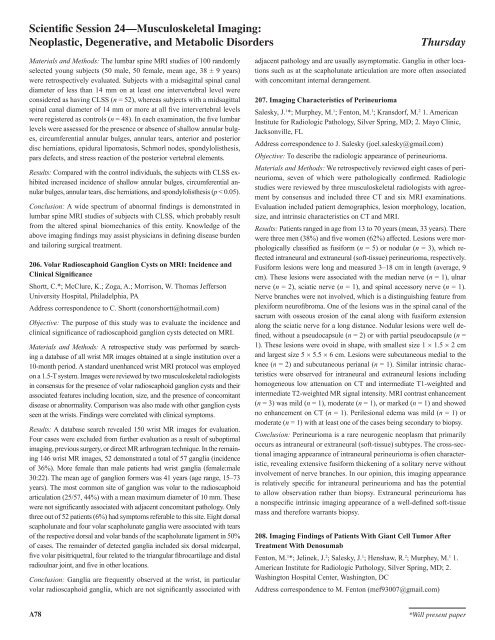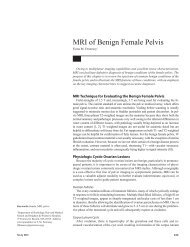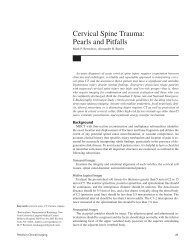Scientific Session 1 â Breast Imaging: Mammography
Scientific Session 1 â Breast Imaging: Mammography
Scientific Session 1 â Breast Imaging: Mammography
You also want an ePaper? Increase the reach of your titles
YUMPU automatically turns print PDFs into web optimized ePapers that Google loves.
<strong>Scientific</strong> <strong>Session</strong> 24—Musculoskeletal <strong>Imaging</strong>:Neoplastic, Degenerative, and Metabolic DisordersThursdayMaterials and Methods: The lumbar spine MRI studies of 100 randomlyselected young subjects (50 male, 50 female, mean age, 38 ± 9 years)were retrospectively evaluated. Subjects with a midsagittal spinal canaldiameter of less than 14 mm on at least one intervertebral level wereconsidered as having CLSS (n = 52), whereas subjects with a midsagittalspinal canal diameter of 14 mm or more at all five intervertebral levelswere registered as controls (n = 48). In each examination, the five lumbarlevels were assessed for the presence or absence of shallow annular bulges,circumferential annular bulges, annular tears, anterior and posteriordisc herniations, epidural lipomatosis, Schmorl nodes, spondylolisthesis,pars defects, and stress reaction of the posterior vertebral elements.Results: Compared with the control individuals, the subjects with CLSS exhibitedincreased incidence of shallow annular bulges, circumferential annularbulges, annular tears, disc herniations, and spondylolisthesis (p < 0.05).Conclusion: A wide spectrum of abnormal findings is demonstrated inlumbar spine MRI studies of subjects with CLSS, which probably resultfrom the altered spinal biomechanics of this entity. Knowledge of theabove imaging findings may assist physicians in defining disease burdenand tailoring surgical treatment.206. Volar Radioscaphoid Ganglion Cysts on MRI: Incidence andClinical SignificanceShortt, C.*; McClure, K.; Zoga, A.; Morrison, W. Thomas JeffersonUniversity Hospital, Philadelphia, PAAddress correspondence to C. Shortt (conorshortt@hotmail.com)Objective: The purpose of this study was to evaluate the incidence andclinical significance of radioscaphoid ganglion cysts detected on MRI.Materials and Methods: A retrospective study was performed by searchinga database of all wrist MR images obtained at a single institution over a10-month period. A standard unenhanced wrist MRI protocol was employedon a 1.5-T system. Images were reviewed by two musculoskeletal radiologistsin consensus for the presence of volar radioscaphoid ganglion cysts and theirassociated features including location, size, and the presence of concomitantdisease or abnormality. Comparison was also made with other ganglion cystsseen at the wrists. Findings were correlated with clinical symptoms.Results: A database search revealed 150 wrist MR images for evaluation.Four cases were excluded from further evaluation as a result of suboptimalimaging, previous surgery, or direct MR arthrogram technique. In the remaining146 wrist MR images, 52 demonstrated a total of 57 ganglia (incidenceof 36%). More female than male patients had wrist ganglia (female:male30:22). The mean age of ganglion formers was 41 years (age range, 15–73years). The most common site of ganglion was volar to the radioscaphoidarticulation (25/57, 44%) with a mean maximum diameter of 10 mm. Thesewere not significantly associated with adjacent concomitant pathology. Onlythree out of 52 patients (6%) had symptoms referable to this site. Eight dorsalscapholunate and four volar scapholunate ganglia were associated with tearsof the respective dorsal and volar bands of the scapholunate ligament in 50%of cases. The remainder of detected ganglia included six dorsal midcarpal,five volar pisitriquetral, four related to the triangular fibrocartilage and distalradioulnar joint, and five in other locations.Conclusion: Ganglia are frequently observed at the wrist, in particularvolar radioscaphoid ganglia, which are not significantly associated withadjacent pathology and are usually asymptomatic. Ganglia in other locationssuch as at the scapholunate articulation are more often associatedwith concomitant internal derangement.207. <strong>Imaging</strong> Characteristics of PerineuriomaSalesky, J. 1 *; Murphey, M. 1 ; Fenton, M. 1 ; Kransdorf, M. 2 1. AmericanInstitute for Radiologic Pathology, Silver Spring, MD; 2. Mayo Clinic,Jacksonville, FLAddress correspondence to J. Salesky (joel.salesky@gmail.com)Objective: To describe the radiologic appearance of perineurioma.Materials and Methods: We retrospectively reviewed eight cases of perineurioma,seven of which were pathologically confirmed. Radiologicstudies were reviewed by three musculoskeletal radiologists with agreementby consensus and included three CT and six MRI examinations.Evaluation included patient demographics, lesion morphology, location,size, and intrinsic characteristics on CT and MRI.Results: Patients ranged in age from 13 to 70 years (mean, 33 years). Therewere three men (38%) and five women (62%) affected. Lesions were morphologicallyclassified as fusiform (n = 5) or nodular (n = 3), which reflectedintraneural and extraneural (soft-tissue) perineurioma, respectively.Fusiform lesions were long and measured 3–18 cm in length (average, 9cm). These lesions were associated with the median nerve (n = 1), ulnarnerve (n = 2), sciatic nerve (n = 1), and spinal accessory nerve (n = 1).Nerve branches were not involved, which is a distinguishing feature fromplexiform neurofibroma. One of the lesions was in the spinal canal of thesacrum with osseous erosion of the canal along with fusiform extensionalong the sciatic nerve for a long distance. Nodular lesions were well defined,without a pseudocapsule (n = 2) or with partial pseudocapsule (n =1). These lesions were ovoid in shape, with smallest size 1 × 1.5 × 2 cmand largest size 5 × 5.5 × 6 cm. Lesions were subcutaneous medial to theknee (n = 2) and subcutaneous perianal (n = 1). Similar intrinsic characteristicswere observed for intraneural and extraneural lesions includinghomogeneous low attenuation on CT and intermediate T1-weighted andintermediate T2-weighted MR signal intensity. MRI contrast enhancement(n = 3) was mild (n = 1), moderate (n = 1), or marked (n = 1) and showedno enhancement on CT (n = 1). Perilesional edema was mild (n = 1) ormoderate (n = 1) with at least one of the cases being secondary to biopsy.Conclusion: Perineurioma is a rare neurogenic neoplasm that primarilyoccurs as intraneural or extraneural (soft-tissue) subtypes. The cross-sectionalimaging appearance of intraneural perineurioma is often characteristic,revealing extensive fusiform thickening of a solitary nerve withoutinvolvement of nerve branches. In our opinion, this imaging appearanceis relatively specific for intraneural perineurioma and has the potentialto allow observation rather than biopsy. Extraneural perineurioma hasa nonspecific intrinsic imaging appearance of a well-defined soft-tissuemass and therefore warrants biopsy.208. <strong>Imaging</strong> Findings of Patients With Giant Cell Tumor AfterTreatment With DenosumabFenton, M. 1 *; Jelinek, J. 2 ; Salesky, J. 1 ; Henshaw, R. 2 ; Murphey, M. 1 1.American Institute for Radiologic Pathology, Silver Spring, MD; 2.Washington Hospital Center, Washington, DCAddress correspondence to M. Fenton (mef93007@gmail.com)A78*Will present paper
















